 “It’s hard to define what a green job actually is.”
“It’s hard to define what a green job actually is.”
That’s Michael Myers, an analyst for the Oregon employment department, speaking recently in Florence, on the Oregon Coast, to an audience of anxious members of the local chamber of commerce. He was answering questions about where new employment opportunities will arise and explaining the challenge of counting new, green jobs.
Across Oregon and Cascadia, many are hoping for, and working towards, a new, clean-energy economy that will usher in a healthy, lasting prosperity. There’s abundant reason for hope—even on the Oregon Coast, which has some of the highest unemployment rates in the region.
But green jobs aren’t always easy for employment analysts like Michael Myers to recognize, because they are scattered across most occupations and industries. In fact, every job can be more or less green.
This post lays out several approaches used in recent studies. If you’re not interested in job counting, I suggest you you move along.
There are reasonable ways to define green jobs, and given those definitions, authorities can count them. A decade ago, in Green Collar Jobs, I divided all of Cascadia’s jobs into three categories based on the relative environmental impacts of the industries in which they were found: “green-collar jobs” is what I called those jobs in the lowest impact sectors of the economy such as services and information technology. By this method, most jobs—more than 60 percent of the total—are green-collar jobs.
In recent years, thanks to the leadership of green-economy evangelist and now White House adviser Van Jones, “green-collar jobs” has come to refer to employment directly related to environmental protection and energy security, particularly mid-skill manual labor jobs in those fields. Counting these positions is harder.
Oregon is conducting a survey of green employment now and expects results this fall. British Columbia’s green jobs remain largely uncounted. One 2007 paper examined the size of the environmental business sector in Canada overall, but it used a definition so narrow that it excludes most green work. It also estimated these businesses’ revenues, not their employment, there’s no tally to report. In Washington, two green-economy surveys reported their findings in recent months.
The larger of them, performed by Washington State University (WSU) for the state’s Employment Security Department (ESD), offers this descriptive mouthful as its definition:
- “There is no uniform definition of a green job. In general, jobs that have a direct, positive impact on the environment have become known as green jobs; they include jobs at all levels of the earnings and skills spectrum, from professional-level employment of managers, architects and engineers, to jobs in the skilled trades, which are often referred to as green-collar jobs. Some researchers note that green jobs are represented in nearly all economies, industries, and occupations, suggesting that the question is more about understanding what shades of green exist in an economy. Green jobs are not necessarily new jobs, but often traditional jobs in industries and companies that are adapting to new markets and opportunities available in a clean energy economy. In whichever manner the green economy is defined, however, forecasts about growth in green industries and occupations have also generated keen interest among advocacy groups who emphasize the potential of green jobs to promote jobs and career pathways out of poverty for economically disadvantaged individuals, communities of color, and for dislocated workers.”
If you were in charge of distinguishing green jobs from other jobs, this passage wouldn’t guide you much. For its tally, WSU actually adopted a different and narrower definition: green jobs are those held by employees who devote a substantial share of their work hours to activities that boost energy efficiency and renewable energy or prevent, reduce, or clean up pollution. This definition likely omits many other green jobs, such as those in conservation and restoration of our natural heritage, bicycling and transit, and real-estate development for compact communities. It also excludes everything in the public and nonprofit sectors such as environmental education and advocacy. (Ironically, under WSU’s survey rules, none of Sightline’s staff would count. Not even Van Jones would qualify.)
On the plus side, WSU’s definition does allow a precise census. WSU surveyed more than 9,500 private-sector employers in Washington and found more than 47,000 green jobs—five times more than previously estimated. (Yesterday, Governor Chris Gregoire reported this figure at the Washington State Energy Summit as if it reflected burgeoning growth. She implied that the state had already surpassed her goal of creating 25,000 green jobs. In fact, her goal was set assuming there were fewer than 9,000 green jobs in the state—the best previous estimate. The WSU survey simply looked harder and discovered that more jobs had been there all along.) The 47,000-job figure represents 1.6 percent of private-sector jobs in the state. That’s not a large percentage, but remember, it’s a narrow definition.
The distribution of these jobs is roughly the opposite of popular perceptions: very few jobs—just 4 percent of the total—are in solar or wind power or other renewable energy fields. Most are in the building trades and in agriculture. In fact, by WSU’s methods, the state’s leading green job is farm laborer: Washington employers reported 4,800 farm workers engaged in pollution prevention and reduction. Presumably, these jobs are held by laborers and ag specialists on farms, orchards, and ranches that have adopted organic, sustainable, or other environmentally responsible practices. Washington’s second-ranked green job is electrician: 3,800 electricians show up in the survey as having green jobs. Overall, more than half of green jobs in the survey are in energy efficiency, including not only electricians and other skilled tradespeople such as carpenters but also thousands of construction laborers. Pollution mitigation and cleanup contributed the remaining tenth of green jobs.
Where might future green jobs come from? Among the top 25 green occupations, WSU’s mathematical model for projecting future employment shows uneven growth. The model overall projects only about 667 new jobs a year through 2016—not a very impressive figure. WSU analysts expect farm laborers, electricians, and the other big-number green occupations to accumulate at a low percentage growth rate—more slowly than jobs in the state overall, in fact. They foresee rapid growth, in percentage terms, among rarer j
obs such as architects. Still, because of attrition and retirement, the skilled trades such as carpentry may offer the largest number of openings. WSU expects more than twice as many positions to open in green carpentry each year as in green architecture.
These projections are helpful antidotes to the current tendency to hype green jobs, but at the same time, I believe they substantially understate the potential. Not only are they narrowly focused on a few sectors of the economy, they do not take into account federal stimulus spending on clean energy, the possible advent of comprehensive cap and trade, or the potential of innovations such as Sustainable Works.
A second study of Washington’s green jobs, conducted by Mina Yoo and Michael Verchot of the UW business school, used a broader definition of “green” and unearthed two surprises. Their survey, although much smaller than WSU’s, focused on minority-owned and women-owned businesses and asked different questions. It found that 44 percent of all small businesses earned at least 1 percent of their revenue from sales of environmentally responsible goods and services. That number strikes me as fairly impressive.
The second surprise: Yoo and Verchot’s research contradicts the notion that environmentally responsible goods and services are largely the domain of white, affluent consumers and their businesses. In fact, Yoo and Verchot found that white, black, Latino, and Asian-owned businesses all participated in the green economy in similar proportion. Asian-owned businesses actually lead: almost half of Asian-owned businesses reported participation in the green economy. Black-owned businesses, meanwhile, generated the largest share of their revenue from sales of green products and services.
What this means is that greening our economy may spread economic benefits to a large share of businesses, including minority- and women-owned businesses. People of color suffer unemployment rates up to twice as high as whites, according to Yoo and Verchot. Helping businesses owned by people of color helps other people of color too, because minority-owned businesses tend to employ other people of color.
In the months ahead, we’ll know more about the tally of green-collar jobs, as Oregon completes its survey, and as recipients of federal economic stimulus grants and loans fulfill their obligation to report on green job creation.









Sean
Great article, because defining green jobs will allow us to define just how much of an environmental and economic impact to the earth we live in.Seanhttp://www.greencollareconomy.com
morgan
Alan, thanks for maintaining focus on this topic for as long as you have. It’s great that we’ve been able to expand this discussion beyond enviro circles after so many years.I have trouble with the focus on counting jobs only. I’ll welcome an advancing public dialogue anytime, but we shouldn’t loose track of how talking about and counting jobs of any kind is driven by political palate—every elected official likes to talk about green jobs. This is a good thing, but focusing on green jobs is a bit overly reductionistic and may miss the most powerful aspects of the economic transformations we need. It may even misinform our investment decisions.I think we should move past the label ‘green jobs’ and measure, on the one hand, those pithy places like building efficiency and renewable energy where completely new green jobs are displacing old dirty jobs. On the other hand, we absolutely need to figure out ways to talk about and measure how ‘greenness’ is growing across all sectors of the economy. For example, wouldn’t it be more valuable to discuss green behavior in the work place relative to, say, value added or economic productivity or hours/week? If we’re going to debate investment policy in a green economy, shouldn’t we have information helping us to decide where and how to invest? If we only count green jobs, we probably will only invest in creating new green jobs and not green activities that reach all across the economy. Another trouble I see with counting green jobs only is that I don’t think it tells us directly that we’re reducing our ecological burden. My point is a little more murky here, but the following notion has troubled me for years and is now peaking in my work alongside white collar enviros. Adding more policy analysts to the economy, for instance, doesn’t directly reduce total consumer burden on the environment. The ongoing macro shift that has lead to more white collar jobs does lead to a smaller eco-burden per economic output/productivity, and this is a good thing, but it’s limited. If we all sit around typing at work, while the methods by which all the production of energy and material goods doesn’t change, what have we gained? The iPhones, computers, CFLs and buses need to be built somewhere somehow, don’t they? I think Kenneth Boulding pointed to this very well decades ago when he said that GNP is the cost of our lifestyle not a measure of it. Now back to my Sat morning coffee.
Michael OHare
Thanks for your article on green jobs Alan, I had never thought of it in that much detail before. One thing I do know is that cities such as Curitiba, Brazil and Malmo, Sweden have created many jobs in recycling and renewable energy, which have helped produced strong, local economies. And the success of those cities show what is possible.MikeCities for People